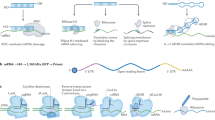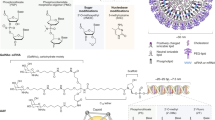Abstract
Gene transfer complexes containing poly-L-lysine (poly-K) and DNA with ligands directed at the serpin enzyme complex receptor (sec-R) deliver reporter genes to receptor-bearing cells in vivo. Expression lasts for about 30 days, when complexes containing long-chain poly-K are used. Extending the duration of expression would be desirable if correction of genetic defects is the goal. To test whether the mechanism by which expression is extinguished was due to an immune response to the transgene, or the loss of the transgene, we conducted two experiments. In the first, we injected sec-R-targeted lacZ complexes intravenously (i.v.) into mice genetically engineered to express this gene briefly during development. These mice, who should recognize the protein as ‘self’, also extinguished lacZ expression after 30 days. In a second experiment, we injected immunodeficient animals with sec-R-targeted human factor IX complexes. A similar temporal pattern of expression was observed in Rag-1 −/− mice, in whom expression also extinguished by 40 days. Moreover, factor IX plasmid DNA was detected in the lung and spleen 50 days after injection of complexes, suggesting that not all cells which had taken up the transgene had been destroyed. Thus, the host's immune response to the transgene may not account for the loss of reporter gene expression from these molecular conjugates. We further tested whether repeat administration of sec-R-targeted complexes will be limited by host immune responses. Mice were pre-dosed twice with sec-R-targeted complexes containing lacZ over a 40-day period. We then injected the animals i.v. with sec-R-targeted human factor IX complexes and measured gene expression and antibody production. Although 14 of 36 animals displayed low-titer antibodies to the ligand in targeted complex, expression levels were unaffected compared with virgin dosing. When the complexes were administered three times intranasally (n=10), no antibodies against the complex were detected in blood. Plasma from mice dosed with saline, nontargeted complex or naked DNA did not react with the ligand, ligand-poly K conjugate or targeted complex. All animals exhibiting human factor IX expression developed antibodies to that transgene by 21 days. Thus, at least three repeat administrations of sec-R-directed molecular conjugates are possible, provided that immune responses to the transgene itself are not limiting.
This is a preview of subscription content, access via your institution
Access options
Subscribe to this journal
Receive 12 print issues and online access
$259.00 per year
only $21.58 per issue
Buy this article
- Purchase on Springer Link
- Instant access to full article PDF
Prices may be subject to local taxes which are calculated during checkout







Similar content being viewed by others
References
Ziady AG, Davis PB . Molecular conjugates. In: Curiel DT, Douglas JT (eds). Vector Targeting for Therapeutic Gene Delivery. John Wiley and Sons, Inc.: Indianapolis, IN, 2002, pp 63–86.
Ziady AG et al. Gene transfer into hepatocyte cell lines via the serpin enzyme complex (SEC) receptor. Am J Physiol 1997; 273 (Gastrointest. Liver Physiol. 36): G545–G552.
Perlmutter DH . The SEC receptor: a possible link between neonatal hepatitis in α1AT deficiency and Alzheimer's disease. Pediatric Res 1994; 36: 271–277.
Perlmutter DH et al. Identification of a serpin-enzyme complex (SEC) receptor on human hepatoma cells and human monocytes. Proc Natl Acad Sci USA 1990; 87: 3753–3757.
Joslin G et al. Amyloid-β peptide, substance P, and bombesin bind to the serpin enzyme complex receptor. J Biol Chem 1991; 266: 21897–21902.
Ziady AG et al. Functional evidence of CFTR gene transfer in nasal epithelium of cystic fibrosis mice in vivo following luminal application of DNA complexes targeted to the serpin-enzyme complex receptor. Mol Ther 2002; 5: 413–419.
Joslin G et al. The SEC-receptor recognizes a pentapeptide neodomain of α1AT-protease complexes. J Biol Chem 1991; 266: 11282–11288.
Ziady A et al. Chain length of the polymer portion of receptor-targeted DNA complexes modulates gene transfer both in vitro and in vivo. J Biol Chem 1999; 274: 4908–4916.
Ziady A et al. Ligand substitution of receptor targeted DNA complexes affects gene transfer into hepatoma cells. Gene Therapy 1998; 5: 1685–1697.
Mendelsohn C et al. Developmental analysis of the retinoic acid-inducible RAR-beta 2 promoter in transgenic animals. Development 1991; 13: 723–734.
Herzog RW et al. Stable gene transfer and expression of human blood coagulation factor IX after intramuscular injection of recombinant adeno-associated virus. Proc Natl Acad Sci USA 1997; 94: 5804–5809.
Zhang HG et al. Hepatic DR5 induces apoptosis and limits adenovirus gene therapy product expression in the liver. J Virol 2002; 76: 5692–5700.
Dematteo RP et al. Cellular immunity delimits adenoviral gene therapy strategies for the treatment of neoplastic diseases. Ann Surg Oncol 1999; 6: 88–94.
Yang Y, Wilson JM . Clearance of adenovirus-infected hepatocytes by MHC class I-restricted CD4+ CTLs in vivo. J Immunol 1995; 155: 2564–2570.
Kennedy DW, Abkowitz JL . Kinetics of central nervous system microglial and macrophage engraftment: analysis using a transgenic bone marrow transplantation model. Blood 1997; 90: 986–993.
Kay MA et al. Evidence for gene transfer and expression of factor IX in haemophilia B patients treated with an AAV vector. Nat Genet 2000; 24: 257–261.
Park F, Ohashi K, Kay MA . Therapeutic levels of human factor VIII and IX using HIV-1-based lentiviral vectors in mouse liver. Blood 2000; 96: 1173–1176.
Zhang G, Budker V, Wolff JA . High levels of foreign gene expression in hepatocytes after tail vein injections of naked plasmid DNA. Hum Gene Ther 1999; 10: 1735–1737.
Doerfler W et al. Promoter inactivation or inhibition by sequence-specific methylation and mechanisms of reactivation. Cell Biophys 1989; 15: 21–27.
Jain VK, Magrath IT . A chemiluminescent assay for quantitation of beta-galactosidase in the femtogram range: application to quantitation of beta-galactosidase in lacZ-transfected cells. Anal Biochem 1991; 199: 119–124.
Herweijer H et al. Time course of gene expression after plasmid DNA gene transfer to the liver. J Gene Med 2001; 3: 280–291.
Bouvet M et al. Suppression of the immune response to an adenovirus vector and enhancement of intratumoral transgene expression by low-dose etoposide. Gene Therapy 1998; 5: 189–195.
Ferkol T et al. Immunologic responses to gene transfer into mice via the polymeric immunoglobulin receptor. Gene Therapy 1996; 3: 669–678.
Ziady AG et al. Transfection of airway epithelium by stable PEGylated poly-L-lysine DNA nanoparticles in vivo. Mol Ther 8: 936–947.
Lin WC, Culp LA . Selectable plasmid vectors with alternative and ultrasensitive histochemical marker genes. Biotechniques 1991; 11: 344–351.
Maniatis T, Frinsch EF, Stambrook J . Molecular Cloning: A Laboratory Manual. Cold Spring Harbor Laboratory Press: Cold Spring Harbor, NY, 1989.
Perales JC et al. Gene transfer in vivo: sustained expression and regulation of genes introduced into the livers by receptor targeted uptake. Proc Natl Acad Sci USA 1994; 91: 4086–4090.
Glantz SA . Biostatistics. McGraw-Hill Company: New York, NY, 1987, pp 287–355.
Acknowledgements
We thank Drs Mark Cooper, Anna van Heeckeren, and Mrs Alma Wilson for their expertise, Dr Jeff Whitsett for providing the RARβ-2lacZ-FVB/N mice, and Dr Thomas Ferkol for valuable discussions. This study was supported by the National Institute of Health grants RO1 DK 52981 (PD), P30 DK27651 (PD), T32 HL07653 (AZ), T32HL07415 (AZ), and the Cystic Fibrosis Foundation.
Author information
Authors and Affiliations
Rights and permissions
About this article
Cite this article
Ziady, AG., Kim, J., Colla, J. et al. Defining strategies to extend duration of gene expression from targeted compacted DNA vectors. Gene Ther 11, 1378–1390 (2004). https://doi.org/10.1038/sj.gt.3302299
Received:
Accepted:
Published:
Issue Date:
DOI: https://doi.org/10.1038/sj.gt.3302299



